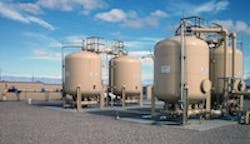Maintaining Sustainability in Tucson
A sustainable business has no negative impact on the global or local environment, community, society or economy. The business must incorporate the three basic principles of sustainability into each of its business decisions. These principles, in order of importance, are: money, people and the environment. Sahuarita Water Co. LLC (SWC) is a sustainable or “environmentally friendly” business, ensuring that its system operations fully address all current and potential environmental concerns while maintaining a profit and a positive balance sheet.
Sahuarita Water Co. is located approximately 20 miles south of Tucson, Ariz. The water company is a privately owned water utility covering a 4.7-sq-mile area and providing water to more than 12,000 residents living in more than 4,700 homes. They also supply water to three campuses of the Sahuarita Unified School District and several commercial properties including the Marketplace shopping center.
To meet the demands of a growing community, in 2008 Layne Christensen Co. was brought in to drill, case and develop a new production well with all of the associated pumping equipment. Along with the new well, the SWC had two existing wells, which were both over the Maximum Contaminant Limit (MCL) of 10 parts per billion (ppb) of arsenic. The decision was ultimately made to centrally treat these wells to minimize capital and operating costs, maintain the visual esthetics of the town and minimize commercial traffic coming and going to the plants.
Pilot Testing
SWC looked at both coagulation filtration and adsorption for the application. With only nine full-time employees and a system that needed to be operational within a year, the decision was made to go with adsorption to reduce required maintenance and the cost of hauling sludge. The two leading adsorption media were pilot-tested side by side. These media were Granular Ferric‐Hydroxide (GFO or E33) manufactured by Severn‐Trent in Germany and LayneRT, a hybrid iron‐based adsorption resin manufactured in the U.S. by Layne Christensen.
At the completion of the pilot study, the GFO produced 15,000 bed volumes (bv) before breaking through the MCL at 10 ppb. The LayneRT produced 23,000 bv before breaking through to 10 ppb of arsenic. Aside from LayneRT outperforming GFO by more than 50% in capacity of arsenic removed per bv, other factors weighed into the decision made by SWC. As a resin-based media, it produces no fines, does not require backwashing and produces no onsite waste—all factors that reduce operator maintenance and required training.
“The ease of operation of a LayneRT adsorption system as a ‘simple filter,' as opposed to the complex backwashing needs of a GFO system, matched the minimum-staff-impact philosophy Sahuarita Water Co. had adopted for the arsenic treatment system,” said Mark Seamans, former president of SWC. "As a sustainable business, the first items that needed to be considered in the evaluation process were the capital and operational costs of the system and the potential liability down the line in regards to arsenic-laden wastes."
A Proactive Solution
SWC decided to be proactive and selected a technology that minimized the liability associated with arsenic-laden wastes. Using a regenerable resin, the waste is generated offsite by Layne Christensen and disposed of in a hazardous landfill even though the waste currently passes all the state and federal requirements for disposal at a standard landfill. Not only does this approach reduce the operational cost of the system while eliminating the potential legal battle if the regulations change, but it also incorporates an honest concern for the well‐being of the environment and the future of the people in the community.
Layne Christensen guaranteed 59,715 bv through the lead vessels after the system was scaled up and those vessels were taken offline for regeneration at the beginning of August 2011. When the vessels were taken offline at 8 ppb of effluent arsenic, they had treated 66,082 bv. As Sahuarita Water Co. is locked into a regeneration rate—which includes loading, unloading, regeneration and transportation—the extra bed volumes mean extra money for the company. The regeneration takes place at the new 60,000-sq-ft Layne Christensen NSF‐certified regeneration facility in Phoenix.
Maintaining a water system with sustainability in mind is a difficult task when treating for any constituent. In SWC’s case, the constituent was arsenic, and the technology selected was LayneRT based on money, potential liability, a secured quality of life for the people in the community and a general concern for the environment.
Michael R. Boyd is a technical sales engineer for Layne Christensen Co. Boyd can be reached at [email protected].
